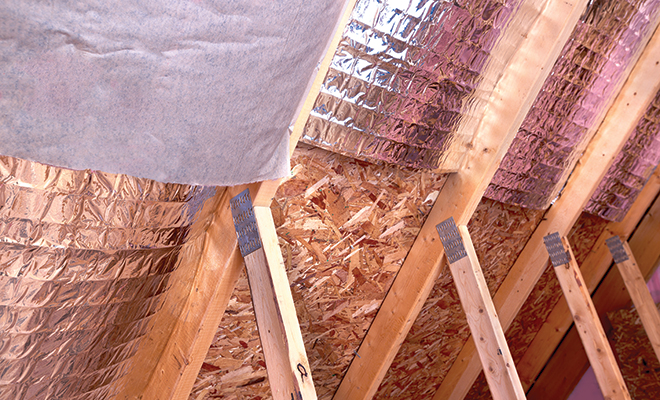
Heat Barriers: Strategies for Staying Cool
Typically, you find radiant heat barriers installed in attics of homes in various areas of the United States. This highly reflective material is used to decrease cooling costs by putting the shade on summer heat gain.
“It basically lies on top of your attic insulation. Sometimes it’s secured, stapled or nailed to the attic rafters in your roof,” advised Mike Faulconer, certified home inspector. “Radiant heat barriers act as a barricade to keep heat from coming in and preventing infiltration of hot air into your living space.”
Hot climates in the United States such as California, Florida, Texas, Arizona and others offer more opportunities for radiant barriers to be effective, especially when cooling air ducts are located in the attic, as compared to homes in cooler climates. According to the U.S. Department of Energy, “Some studies show that radiant barriers can reduce cooling costs five to ten percent when used in a warm, sunny climate. The reduced heat gain may even allow for a smaller air conditioning system. In cool climates, however, it’s usually more cost-effective to install more thermal insulation than to add a radiant barrier.”
“Radiant heat barriers are thin, paper-like reflective substances that are installed along the underside of your roof,” advised Ben Meyer, certified energy auditor. “Depending on your location in the United States, especially where there is more powerful sunshine on a regular basis, its application can help you realize savings as part of an energy conservation and comfort program.”
Going back to our natural science classes in school, we learned that heat moves from warm areas to cool ones due to conduction, convection and radiation heat flow. A teacher’s lecture might have included an experiment of placing a spoon in a hot cup of coffee and then asking a volunteer to carefully touch the spoon. She felt the warmth of the coffee through the spoon because the energy transferred from the hot one to the cool one. This is conductive heating.
Applying this knowledge to our homes means that in the winter, heat transfers from warm areas in your home to unheated spaces and the outdoors. During the summer months, heat travels from the warm outdoors to the cooler interior of your home. Most homeowners know insulation materials increase the energy efficiency of their houses by reducing the amount of heat escaping from it in the winter or decreasing conductive heat flow. In the summer months, it retains the cold air and keeps the house from getting too warm.
But radiant barriers work in a different way by reducing the radiant heat transfer from the underside of the roof to other surfaces in the attic. Radiant heat journeys from any surface and heats anything solid that absorbs its energy. It’s largely radiant energy that produces an incredibly hot roof when the sun bears down on it. Due to conduction, much of that resulting warmth travels through the roofing materials to the attic. The hot roof material releases its heat energy onto cooler attic surfaces. Many times, these are air ducts and the attic floor.
A radiant barrier’s effectiveness depends on proper installation. For instance, the reflective surface must face an air space, yet dust accumulation on the reflective surface must be minimized. If not, its reflective capability will be greatly reduced.
It’s easier to incorporate radiant barriers into a new home, but you can also install them in an existing home, especially if it has an open attic. The Department of Energy recommends using a certified installer. However, if you choose to do the installation yourself, research details on reflective insulation trade association websites, carefully study and follow the manufacturer’s instructions and safety precautions and check your local building and fire codes.
“Radiant heat barriers can be a good thing for some parts of the country, but it’s an added expense that isn’t typically incorporated into new construction,” noted Mike. “More often it’s used by the homeowner as a retrofit rather than in new construction.”
“Certainly, there are some energy savings that can be done on your own, but when you get in your attic, one wrong step and you can end up in your living room. Then you’re climbing up the side walls of your attic, which can be dangerous,” remarked Ben. “Frankly, on the list of things that you could install as a do-it-yourself project in your house for energy savings and increasing the comfort in your home, I would put this dead last.”
To increase the comfort levels of your home, radiant heat barriers can help you maintain a consistent, uniform temperature from room to room. It can also increase your home’s energy efficiency and lower heating and cooling bills. Whether it’s a fit for your home in your region is a discussion that should happen with experts on the subject. ■
Sources: energy.gov and radiantguard.com.







